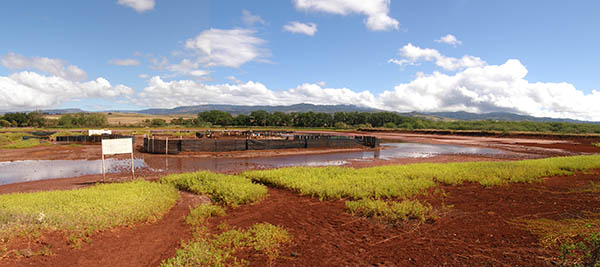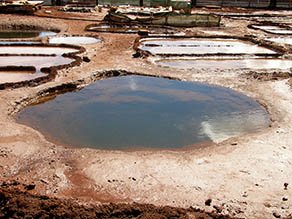 |
 |
 |
|||||
|
He Ho‘ohana i Ka Pa‘akai – The Making of Hawaiian Salt
Salt crystallising in the lo‘i pa‘akai in Hanapepe. Essay provided by Momi Ka‘iakapu "The process of crystallizing your goals and dreams into reality, takes time, knowledge, diligence, and faith to overcome all obstacles, to achieve what is hoped for. This is one of the underlying lessons learned through E Hana i Ka Pa‘akai; the making of Hawaiian salt. "It is a hot April day in Hanapepe, Kaua‘i. The winter waters that once filled and covered the entire area of the lo‘i pa‘akai (salt bed area), have receded, revealing once again the remnants of the lo‘i from the seasons previous. The walls of the salt beds looks a little weathered but have withstood another stormy winter. "Out here, you can‘t help but kū‘āina. I can feel the heat of the sun and the warmth of the breeze. There are no trees to lend for a pleasant shade. In fact, my skin begins to burn a little because of the intense heat and salt that is present in the air. If you are not kama‘aina to this area, you would probably view this place as nothing more than acres of mass, flat red mud. Nothing much to look at, and it is hard to think that anything precious could come out of this place. The physical eyes can be deceiving. The salt bed area at Hanapepe. "I take a deep breath before stepping foot onto the salted, alaea, red clay-dirt area. It is a special place to me. A place where my kūpuna, for many generations, have labored and practice the art of making pa‘akai. The art of making pa‘akai is done in the same fashion today. The wahi pana is a place like nowhere else in the world. Underneath this mass mud flat lies layers of sea salt that makes it unique in its design. The kūpuna say it was naturally created and make salt. Within the salt layers, exist tunnels of water that seep through the salt, making the salinity levels in the water, very high. "It is an elite place. Only descendants of those families, who were given the kuleana of he ho‘ohana i ka pa‘akai, by the Ali‘i, are allowed to work and continue the practice today. But all are free to visit and witness the work being done. And if you are fortunate, you may be invited by one of these ‘ohana, to participate in the labor and harvest. "The season begins as families return, after the water-covered area of winter, has receded; the ground has hardened, allowing the salt makers to work the lo‘i pa‘akai (salt patches). My ‘ohana has a fairly large section to tend to. In it, there are three punawai (salt water wells), eleven lo‘i pa‘akai, and three waikū (standing water area.) During a good hot summer, my ‘ohana and I can produce up to 200 gallons of salt each month during the season which normally begins in April and last through late November.
"The lo‘i and waikū are also rebuilt and resurfaced. On our hands and knees, each lo‘i and waiku is rubbed with a pohaku (rock) and water, to bring together the dirt and clay. The goal is to create a solid, leak-proof surface that can withstand the wind, rain and the heat of the sun during the entire season. It is a laborious work and can be very hard on the body. This process requires stamina, diligence, technique, a willingness and humility. "Once the punawai have been cleaned, the waikū and the lo‘i pa‘akai have been resurfaced and they are now ready for salt making. Water from the punawai is gently poured into the lo‘i and the waikū. During the hottest period of the day, the sun will do its work of crystallizing the water into salt flakes that form on the surface of the water, them eventually falls to the bottom of the lo‘i. As a salt maker, I am mindful that it be done carefully and slowly so that the process of pouring new waters into the lo‘i does not disrupt the salt flakes that have already formed. "It is a conscious effort that takes time and awareness. I normally feed the water into the lo‘i at the end of the day. It is a pleasant time for me to enjoy nature, the sunset, and the sound of the ocean. A time to create salt, by feeding the lo‘i. After a few weeks and if weather permits, diligence, hard work, knowledge, and faith, has lend way to a day of reaping what we have sown; pa‘akai. What was once just salt water has now crystallized into pa‘akai. The harvest is shared with family and friends, and the process begins again. "I am always humbled, in wahi pana that breeds hard labor. It teaches me and keeps me grounded to the very roots of my kūpuna and to be thankful for all that they have left here for me to learn. The preparation and work that encompasses turning salt water into pa‘akai, are parallel to achieving life‘s goals. It is the same efforts that one can apply to transforming what is just a thought, into reality of the goals that are desired.
"Through the work of our kūpuna, like he ho‘ohana i ka pa‘akai, there are lessons in the hana [work] that are hidden, that can be found. If we pay close attention, we find that it is during the process of being engaged in the work of our kūpuna, that it exposes wisdom and knowledge that are found to be deeply rooted in the very nature of our Hawaiian values. "A wealth of ‘ike or knowledge that reveals lifelong lessons and values that guides us through the journey of life. It makes me ever aware of how much intelligence our kūpuna possessed and how important my relationship with ke Akua, ka ‘ohana, ka ‘āina a me nā po‘e a pau are. (with God, my family, the land and people). There is much to be learned and much to be shared...And so we take up our kuleana of sharing our heritage with others, in the hopes that they too, may live a life of purpose and fulfillment of giving and sharing aloha by example."
|
|
|||||
|
Pacific Worlds > Hā‘ena, Kaua‘i > Health > Internal Treatments |
||||





